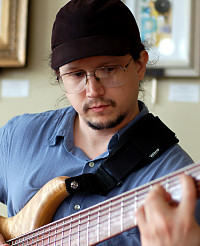
Seven-string electric bass arrangements of works by
the Baroque composer Johann Sebastian Bach

About This Project
The first time I heard Bach played on the electric bass was in the mid 1980s when I bought Jaco Pastorius' album Word of Mouth. He played an excerpt from Bach's Chromatic Fantasy and Fugue (BWV 903).
There was also the famous Jethro Tull version of the Bourrée movement from the Lute Suite in E Major (BWV 996) which was simply entitled Bourée (sic).
I actually played Jethro Tull's Bourée in my first rock band in high school in 1985.
In the late 1980s, bassist Jeff Berlin published the left and right-hand parts of Bach's Prelude in C minor from the Well-Tempered Clavier in two separate articles for Guitar Player magazine.
I played these works a little bit but by that time, I was gravitating towards jazz music and started working on learning music theory and attempting to play jazz. Never did get the hang of that though.
It wasn't until around 1992 when I bought my first Bach CD. It was the Cello Suites performed by Yo-Yo Ma.
I was immediately hooked on Bach. I bought the sheet music for the Cello Suites and started working on memorizing the first Cello Suite.
Shortly thereafter, I bought a copy of Henryk Szeryng's Sonatas and Partitas for Solo Violin.
Likewise, I bought the sheet music for that as well.
The Gavotte en Rondeau movement from the 3rd Partita for Solo Violin had been featured in Carl Sagan's Cosmos years before and I had often listened to the soundtrack.
Naturally, I had to work on that movement first.
Even before I started playing Bach, I was attracted to contrapuntal and chordal music and had bought my first 6-string bass in 1992. This made it much easier to play these works without having to transpose individual phrases to fit the instrument.
Ever since then I have been working on my own arrangments of these works on electric bass.
At first, I would try to memorize them by working directly from the sheet music.
I could read bass clef music a little so that wasn't terribly difficult but when I started working on the solo violin works, I found it more difficult to read the treble clef.
I also found that if I didn't work on a piece for a while, I would forget the finger positions I had used.
So, I started notating my arrangements in tablature by hand.
A few years later, I got a copy of Passport Encore which had the ability to import MIDI files and create editable tablature.
I had already been working on MIDI versions of the solo cello and solo violin works and I started importing them into Encore and editing the tablature from there.
I've been working on tweaking these Encore scores ever since then.
In 2001, I switched from 6-string bass to 7-string bass.
While the solo violin and solo cello works were about 99.9% playable as-written on 6-string bass, I wanted a 7-string bass because I started working on the Bach Inventions and Sinfonias for solo keyboard.
This required slightly more range than was available on six strings.
The 7-string bass also made it much easier to play the solo violin works as well as the 6th solo cello suite which was written for a 5-string cello.
My arrangements are about 99.99% true to the original scores.
The divergences from the original scores are generally places where there is a unison (two of the same note played on different strings) that requires an open string to be playable.
Due to the tuning differences between a 7-string bass and a violin or cello, some of these unisons are unplayable.
In those cases I often drop one of the voices down an octave or omit it.
In other cases there are notes that are meant to be held a little longer but due to fingering issues, they must be cut short.
However, that is often the case when playing these works on a cello or violin anyway.
So, I hesitate to call my versions "transcriptions".
I've performed just over half of these works live.
I can't say that I've done any recordings that I'm truly happy with.
These are difficult pieces and I require many hours of warm-up time to be able to play these works well.
That is rarely an option when doing a live performance.
The Sonata in G minor for Solo Violin that I performed at Solo Bass Night III is the recording that I am happiest with (see my Audio and
Video pages for audio and video recordings). Though, it is still imperfect.
However, I am now confident that given enough rehearsal time and enough recording time, I can record versions that I will be happy with.